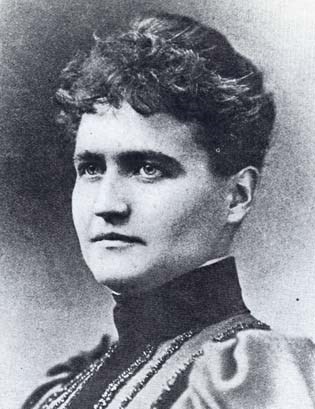Last updated: March 19, 2019
Article
Eliza Scidmore’s Faithful Pursuit Of a Dream

Courtesy Washingtoniana Division, D.C. Public Library
Fewer know that the trees are also a testament to one woman's persistence and the value of never giving up on a dream.
In 1885, 29-year old Eliza Ruhamah Scidmore returned to the United States following her first visit to Japan, where her brother George worked for the US Consular Service. While there, she developed a great appreciation for the Japanese people, culture, and the beauty of the Japanese flowering cherry trees. She brought back with her a desire to introduce the beauty of Japanese cherry blossoms to the American people.
Upon returning to Washington, DC and resuming her life as an author, travel writer, newspaper correspondent, and photographer, Scidmore began promoting her idea of planting flowering cherry trees in Potomac Park on land recently reclaimed from the Potomac River. As she explained in a 1928 newspaper article in the Washington Sunday Star, "...since they had to plant something in that great stretch of raw, reclaimed ground by the river bank, since they had to hide those old dump heaps with something, they might as well plant the most beautiful thing in the world—the Japanese cherry tree."
Over the next 24 years, she presented her idea to every Superintendent of Public Buildings and Grounds, but her pleas were met with little interest.
One superintendent turned down her request, expressing concern that policemen would have to be in the park day and night when the cherries were ripe to keep boys from climbing the trees and breaking the branches. When she explained that the types of trees she was proposing produced only blossoms, not cherries, she recalled receiving the following response: "What! No cherries! No cherries! Huff! What good is that sort of cherry tree?” (The trees do produce a small inedible dark cherry sometimes eaten by birds.)
Scidmore recalled that her requests "were of no avail, no matter how fervent, long or often repeated to successive indifferent and obdurate S.P.B.G.s (Superintendents of Public Buildings and Grounds)."
During the later years of her efforts, Department of Agriculture Plant Explorer David Fairchild began experimenting with and advocating for the introduction of Japanese flowering cherry trees in the United States. Following the successful planting of several varieties on his personal property in Chevy Chase, MD and in the neighboring area, he began promoting the idea of planting Japanese flowering cherry trees along avenues in the nation’s capital. His efforts included supplying cherry trees to children to plant in Washington, DC schoolyards on Arbor Day in 1908.
On the day preceding the event, Scidmore talked with Fairchild about her dream of planting Japanese cherry trees on the newly reclaimed land of Potomac Park. Fairchild expressed enthusiasm for her idea, and invited Scidmore to attend the lecture he would be presenting at the conclusion of the Arbor Day event. At this event, he publicly promoted the idea of planting cherry trees along the Speedway (a popular roadway in Potomac Park, in the area of present day Independence Avenue.)
Both Scidmore and Fairchild began working on plans to acquire trees for the park. At the White House, First Lady Helen Taft was working on plans to beautify this area.
Fairchild offered to import Japanese cherry trees for the project.
Scidmore developed a plan to solicit annual subscriptions of one dollar from travelers who had personally experienced the beauty of the trees. She hoped to then be able to donate 100 trees each year, so that after ten years, "there would be a great showing in Potomac Park--a rosy tunnel of interlaced branches, a veritable Mukojima along the river's bank." She then sent a note to First Lady Taft, requesting her approval for the plan and assistance in acquiring the trees.
At long last, Scidmore experienced success. Two days after sending her note, she received a positive response from the First Lady. Not only did Taft like the idea, she immediately made arrangements to acquire some cherry trees for Potomac Park. The First Lady had spent time in Japan where she had experienced firsthand the beauty of the cherry blossoms.
The day after Taft's letter was written, noted Japanese chemist Dr. Jokichi Takamine learned of the plan to acquire cherry trees for America's capital city. He was in Washington, DC at the time with New York's Japanese consul general Kokichi Mizuno. Takamine asked Mizuno to inquire whether Mrs. Taft would accept a gift of 2,000 trees for the city. The consul general liked the idea and suggested donating the trees in the name of Tokyo. Takamine generously agreed, and Mrs. Taft accepted the offer.
The cherry trees were shipped across the ocean to Seattle and arrived in Washington, D.C. in 1910. A major setback occurred when U.S. Department of Agriculture (USDA) inspectors discovered that the trees were diseased and infested with insects. Following thorough inspections, USDA officials advised that the trees be burned to prevent harm to native plants.
Such an awkward situation was handled most graciously by Japanese officials. Not deterred, Tokyo Mayor Yukio Ozaki and other officials quickly made arrangements for a new gift of 3,020 trees. Twelve varieties of trees (of which Yoshino was the predominant variety) were prepared and carefully monitored to ensure that they were free of diseases and insects, before being shipped to the United States. After arriving in Washington, DC in March of 1912, the trees were successfully planted along the Tidal Basin and in other areas of Potomac Park and the city.
Fewer than 100 of these original trees survive today among the nearly 4,000 cherry trees growing in West and East Potomac Parks, on the Washington Monument grounds, and in several other park locations.
Today, these trees stand not only as a powerful symbol of friendship between nations, but as an inspiring reminder of the difference one person can make by faithfully pursuing a dream.
